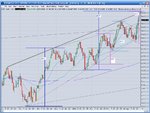Interesting article from another BB - so don't know the source.
Ready For Anything
Wednesday, April 19, 2006
The prices of both oil and gold continue to rise; the former is now trading at nominal all-time highs, while the latter has been hitting new quarter-century highs day after day. This is excess liquidity coming home to roost. While the Federal Reserve continues to raise interest rates to mollify foreign central banks, it’s made it clear that any weakness in either the stock market or economy will be met with massive infusions of liquidity, and dollar-denominated debt will be inflated away.
The world is waking up to this, which is why oil and gold march inexorably higher and the long bond is tanking. This is inflation, and the rest of the world is acting accordingly. Today, Iran’s President Ahmadinejad said, "The global oil price has not reached its real value yet.” He’s right, of course. He knows that every dollar he receives for his oil today will be worth less tomorrow, so Iran (and OPEC) is demanding ever-higher prices for its only natural resource. The nerve, eh? We won’t take that lying down, which is why the marketing of Target Iran is in full swing. Our ability to print our way through debt, economic weakness, and preemptive wars is at stake.
You didn’t really think it was all about "WMD’s" did you?
If you’re wondering why the stock market acts well in the face of skyrocketing oil and various other problems, the answer is that stocks are doing exactly what the White House and Federal Reserve want them to do - for now. If your costs - food, healthcare, clothing, tuition, energy - are rising at double-digit rates every year, are you going to keep your savings in a money market fund or treasuries? You’ll be destroyed by inflation. So now, out of necessity and desperation, investors take more risk. Speculation increases. You start to see articles in the mainstream media like this one titled "3 Prime Picks from the Pink Sheets," a reference to the seedy underbelly of the stock market. You get "trading contests" on business news channels. You see a Wall Street pundit with his own daily TV show throwing chairs and screaming that he "needs you in this top pick." Of course, a select few benefit enormously from all this. When fiscal and monetary policy go crazy, the investment banks and brokers are like bears perched over a prime spot while the salmon are running. Right now the river is not water, but liquidity.
Make no mistake: ours is radical fiscal and monetary policy with an uncertain but inevitable & unpleasant end game. Few examples exist of advanced, industrialized nations resorting to this. It's an extreme example obviously, but the dynamic of 1920's Germany is similar in many ways. One of the best accounts of that period I’ve read is Sebastian Haffner’s Defying Hitler, a street-level account of the way in which an entire modern nation slowly loses its collective mind. This period in German history has long been a special interest of mine, and I consider this book a must-read. Buy it if you haven't read it. Describing the social and economic effects of inflation during 1923, Haffner writes on pages 55-56.
The cost of living began to spiral out of control. A pound of potatoes which yesterday had cost 50,000 marks now cost 100,000. The salary of 65,000 marks brought home the previous Friday was no longer sufficient to buy a pack of cigarettes on Tuesday.
What was to be done? Casting around, people found a life raft: shares. They were the only form of investment that kept pace---not all the time, and not all shares, yet on the whole they managed to keep up. So everyone dealt in shares. Every minor official, every employee, every shift worker became a shareholder. Day-to-day purchases were paid for by selling shares. On wage days there was a general stampede to the banks, and share prices shot up like rockets. The banks were bloated with wealth. Obscure new ones sprouted up like mushrooms and did a roaring trade. Every day the entire population studied the stock market listings. Sometimes some shares collapsed and thousands of people hurtled toward the abyss. In every shop, every factory, every school, share tips were whispered in one’s ear.
The old and unworldly had the worst of it. Many were driven to begging, many to suicide. The young and quick-witted did well. Overnight they became free, rich, and independent. It was a situation in which mental inertia and reliance on past experience were punished by starvation and death, but rapid appraisal of new situations and speed of reaction were rewarded with sudden, vast riches. The twenty-one-year-old bank director appeared on the scene, and also the high school senior who earned his living from the stock-market tips of his slightly older friends. He wore Oscar Wilde ties, organized champagne parties, and supported his embarrassed father.
That was Germany eighty-three years ago. Anything sound familiar?
So while Germany’s central bank inflated away the nation’s war debts and the prices of daily necessities skyrocketed, the stock market soared as people desperately tried to keep up. And so, Haffner writes, an entire nation became "ready for anything."


